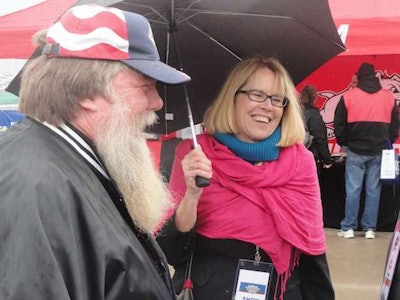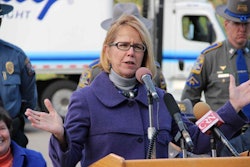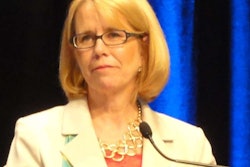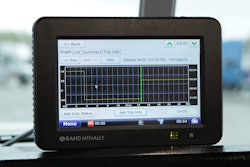 FMCSA Administrator Anne Ferro, in happier times, visits with an OOIDA member at the association’s 40th anniversary “Heart of America Trucking Show” last fall. OOIDA is now calling for Ferro to step down.
FMCSA Administrator Anne Ferro, in happier times, visits with an OOIDA member at the association’s 40th anniversary “Heart of America Trucking Show” last fall. OOIDA is now calling for Ferro to step down.Last week’s Senate Appropriations Committee bipartisan vote to suspend restart provisions in the hours-of-service rule, pending further study, is interesting for a couple of reasons: How might the re-do impact the Federal Motor Carrier Safety Administration’s ambitious regulatory agenda going forward – that’s the big picture question – and what will the suspension mean, practically, for drivers and carriers?
In order of timeliness, let’s talk about what happens next legislatively.
First, drivers or trucking companies for which the consecutive 1-5 a.m. restarts have been painful shouldn’t pop the cork on the champagne just yet.
The amendment is part of an annual budget bill for the DOT, this for fiscal year 2015. The full Senate now must approve the bill, likely part of a budget package Appropriations Chairman Barbara Mikulski hopes to have ready by mid-summer. The House is taking up its version this week, with an amendment free-for-all likely to ensue.
Short answer: Continuing Resolutions – budget extensions to pay the bills based on the 2014 levels – are a very real possibility.
And that means the hours-of-service amendment will be on the sideline for a while.
The good news, for those in favor of the restart rollback, is “the heavy lifting has been done,” as a political insider told me last week.
Oct. 1 is the outside chance for the earliest effective date, but smart money is on adoption in a lame-duck session after the November election, or possibly as late as approval by the new Congress in January or beyond. And the White House must sign off on it.
Now the fun question: What’s to become of Administrator Anne Ferro? The American Trucking Associations say they couldn’t work with her on the restart problems, and so had no choice but to wield their substantial influence on Capitol Hill.
But then, likely after the DOT political staff had counted committee votes, Ferro penned and posted a DOT Fast Lane blog featuring truck crash victims, and proclaimed the agency is protecting families from an industry that wants to undo “life-saving” rules.
“And as a wife and mother of two, I am committed to preventing tragedies like those that have been shared with me,” Ferro writes.
The Owner-Operator Independent Drivers Association was quick to respond, calling on Ferro to resign, citing “a clear bias against truckers and the trucking industry.”
This comes just eight months or so after Ferro was a featured speaker at the association’s 40th anniversary shindig – an event at which she stood in a cold rain chatting with driver after driver.
And Dave Osiecki, executive vice president of national advocacy for the American Trucking Associations, called her blog post “remarkable” when I spoke with him. He also says he submitted a comment to summarize the ATA case – a comment that, pending DOT review, still hadn’t been published a week later.
The agency is “miscommunicating” and “misrepresenting” the fatigue data, Osiecki contends, “and they know it.”
“It’s not enough to proclaim that the rules will promote safety and promote health,” he says. “There has to be some evidence.”
Essentially, FMCSA is not addressing the primary causes of truck crashes, and the crash rate is going up under the current administration.
“They’ve got their eye on the wrong ball,” Osiecki says. “They’re not looking at speed-related concerns; they’re not looking at the other motorists or aggressive driving. The numbers on that sort of enforcement are down about 48 percent under Ferro.”
Of course, as Ferro said in a House hearing in March, she wasn’t hired to help the trucking industry. Still, it’s provocative – and unbecoming — for Ferro to use the tragedies of others for her political purposes but, well, that’s politics.
Is she angling for a job with the highway safety groups who highlight personal horrors in their lobbying efforts, or was she just borrowing from their playbook – opting for a last-ditch emotional appeal to Congress?
Doesn’t matter, although to imply that bureaucrats care more than carriers about the risks truck drivers face every day is the real insult. The essential question is whether she can do the job fairly and effectively.
Trucking is building its case based on data, not on appeals to motherhood.
But these suggestions of a possible crack in FMCSA’s regulatory dam came before the truck accident that injured comedian Tracy Morgan last weekend.
The CNN coverage I saw Monday breathlessly introduced the story by highlighting a truck driver who’d been awake for 24 hours and “yet” a Senate committee had just voted to ease restrictions aimed at fatigued driving.
Such a high-profile event could provide sufficient cover for continued intransigence from FMCSA.
Alas, it’s another distraction and not a solution. Trucking is acutely aware that 10 distractions a day is 10 too many, and FMCSA needs to quit playing politics.
(As a postscript, I’d like to say a little something about the safety groups that seem to have garnered disproportionate influence with FMCSA.
Indeed, some of us in trucking are quick to dismiss anything coming from PATT and CRASH and the like – but they are folks that can be worked with, notes Lane Kidd of the Trucking Alliance.
The alliance, supported by several large carriers, signed on with the safety groups in support of a new, e-log study of the restart – but they opposed the suspension. And Kidd admits he’s taken some heat for it.
“For the most part, I’ve found that they [the highway safety organizations] don’t dislike trucks but they hate unsafe trucks,” Kidd says. “They’re just trying to make sure bad companies and drivers aren’t on the road anymore. It only takes one.”)











